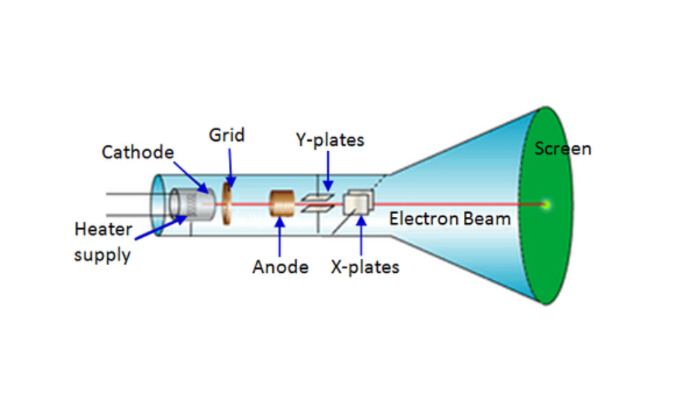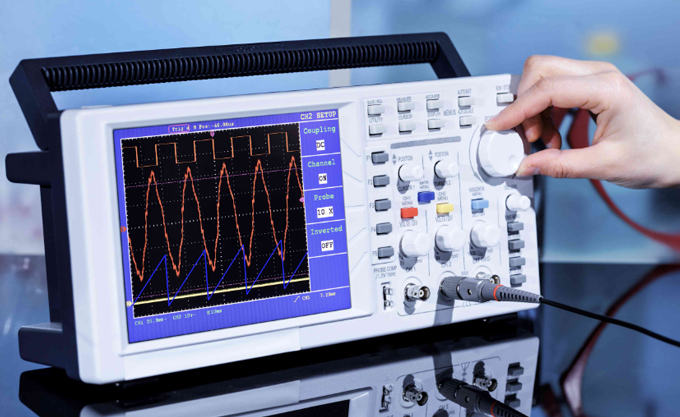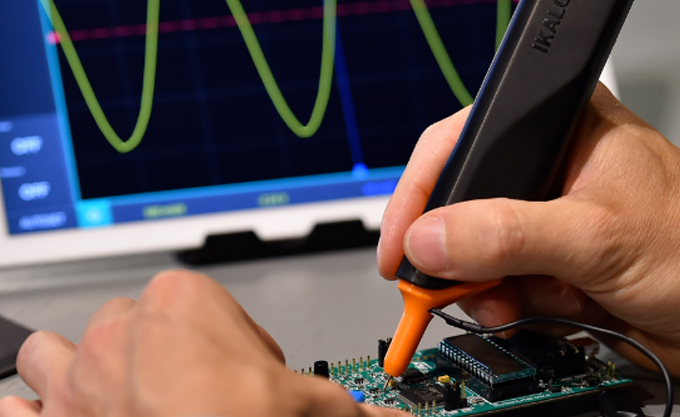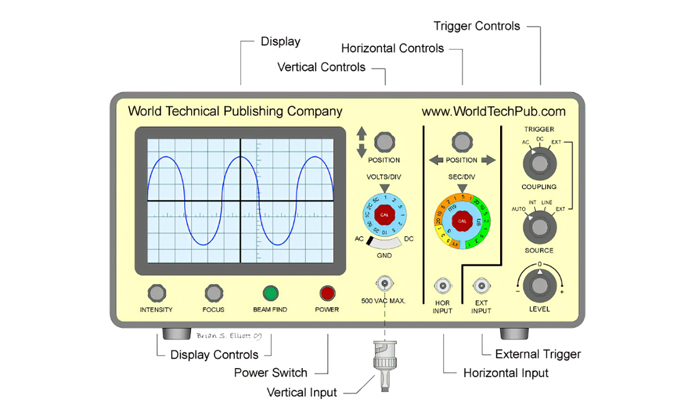Non-introduction from the era of traditional chip domination of the industry, the development of AI chips is not smooth sailing, the bubble is full of, the capital is cold, the scarcity of talent ...... However, in the semiconductor industry as a whole stepped into the downward cycle of the year 2022, the AI chip in turn carried the controversy and questioning, and in the field of servers, automobiles and other areas show an increasingly enlarged value effect.
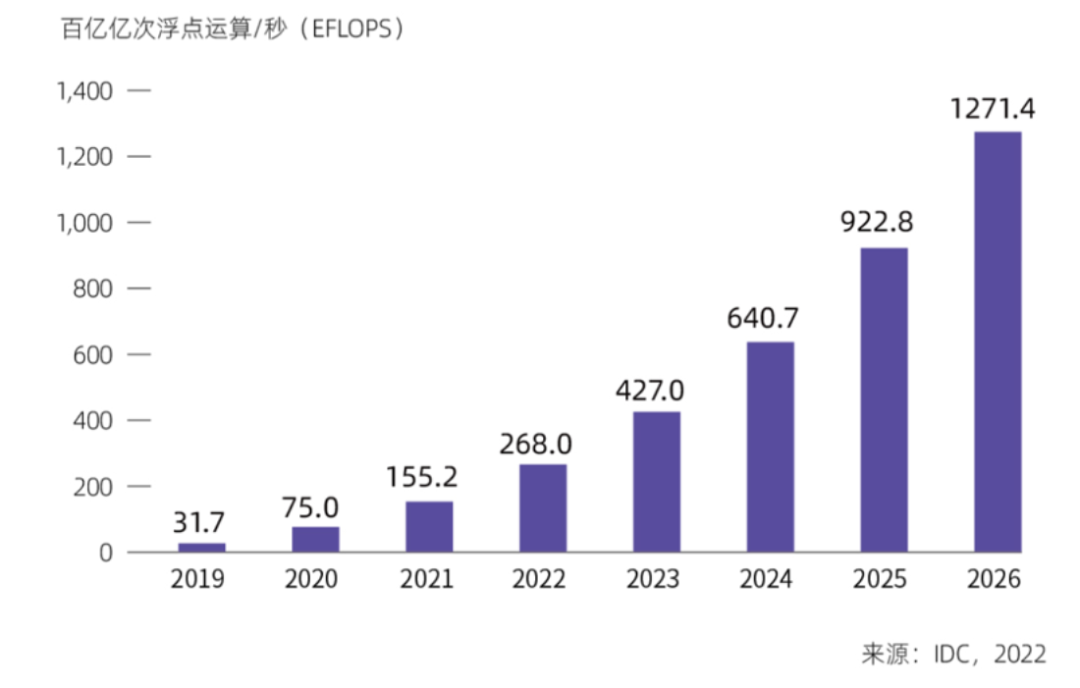 中国智能算力规模及预测(2019年-2026年)
中国智能算力规模及预测(2019年-2026年)
At the same time, the amount of data that needs to be processed by edge computing will become more and more, and the arithmetic requirements will gradually increase. Edge-side equipment is no longer bound to simple data collection, there will be a large number of edge gateway, edge AI, edge scalable servers and other equipment to assist in front-end data processing, the processed data transmission to the cloud, effectively reducing the data pressure on the cloud, users can also be based on their actual business, flexible and close to the choice of the edge computing node or the centre of the cloud computing node.
Edge computing scenarios are roughly two routes: one is a high-performance general-purpose processor as a dedicated device to provide dedicated arithmetic for the scenario; the other is a highly integrated, low-power SoC chip, which reduces power consumption through independent design and at the same time can achieve outdoor field applications for low- and medium-end edge computing devices, which can be deployed in large numbers in industrial and other sites. These solutions can also be overlaid with AI chips, FPGAs, etc., to provide customised algorithms for certain types of scenarios and enhance the ability of edge computing.
From the perspective of AI chips, with the continuous improvement of AI industry technology and the accelerated landing of industrial AI, the global AI chip market will grow at a high rate.IDC expects that the AI chip market size will reach $72.6 billion by 2025. Heterogeneous computing has become the mainstream trend, in the next 18 months, the global AI server GPU, ASIC and FPGA carrying rate will rise, arithmetic diversification trend is obvious.
From the point of view of the development of computing architecture, AI chips designed based on the idea of DSA (Domain-Specific Architectures) are becoming dominant, promoting the diversified development of AI chips. In addition, the support of a general-purpose, green, efficient, safe and reliable computing system is indispensable for the diversified computing power to go from "usable" to "usable" and create business value for enterprises. The industry is promoting the innovation of multi-purpose computing system architecture, based on the interconnection technology within and between computing nodes to break the bottleneck of the existing computing architecture, through the full mobilisation of multi-chip, multi-board card, multi-node system-level capabilities, to achieve a variety of accelerating units and cross-node system for efficient collaboration, to improve computing performance.
From the perspective of scenario application dimension, intelligent scenarios will show a deeper and broader trend with the passage of time.
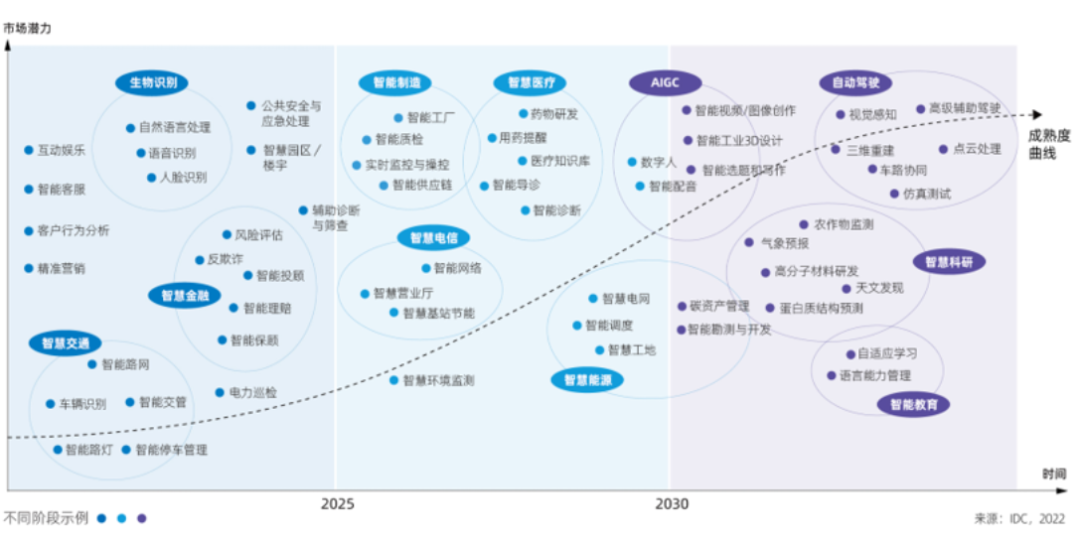
The field of autonomous driving is a key area for the intersection and iteration of chip and AI technologies.
From the beginning of neural network computing to promote automatic driving in a big way, to the higher-order assisted driving perception scheme, with the promotion of the level of automatic driving, the required arithmetic power is almost an exponential explosion, from L2, L3, L4 towards L5, every upward one level at least 10 times more than the arithmetic power needs to improve, massively parallelised AI computing, making the large arithmetic power of the computational platform has become an industrial Must, on the road to improve the effective arithmetic power seems to be never-ending.
Gartner data shows that the global automotive AI chip market is expected to soar to $23.6 billion by 2025 at a compound annual growth rate of 31%. Among them, China's market for automotive AI chips will reach $6.8 billion and $12.4 billion in 2030, with a CAGR expected to reach 28.14%.
Under the surging demand for computing power, host manufacturers have promoted the concept of "hardware pre-buried". Towards L4 level autonomous driving or even L5 level driverless actually need how much computing power is enough? At present, the industry has no definite conclusion, but several thousand TOPS of effective computing power support is considered necessary.
In the domestic market, Horizon Journey 5 has become the first domestic 100TOPS computing power AI chip to achieve front-loading mass production, and this chip is of great significance to Horizon itself, as well as to the development of China's computing power chip. If we compare the competition for self-driving computing power chips to the World Cup, Horizon Journey 5 and NVIDIA are considered to be the first to enter the stage of front-loading mass production of 100TOPS chips, which is equivalent to "locking up a seat in the final in advance".
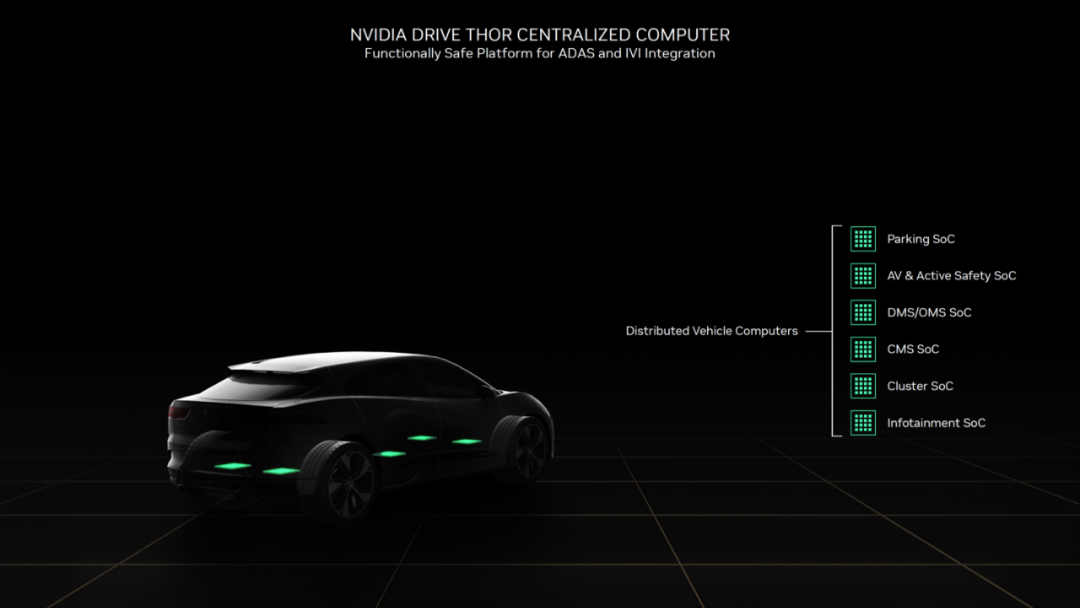
图源 | indian choice
However, in October this year, NVIDIA launched the chip NVIDIA Drive Thor, directly pulling the benchmark up another level, this super chip can achieve a maximum of 2000TOPS AI arithmetic power as well as 2000 TFLOPS floating point arithmetic power. According to the official introduction, NVIDIA Drive Thor is the first self-driving car platform to use an integrated inference Transformer engine, with which it can improve the inference performance of the Transformer deep neural network by up to nine times, which is critical to support the large and complex AI workloads associated with autonomous driving Transformer.

AI补全《富春山居图》过程(图源 | 央视)
Also hot is AIGC (Generative AI), a series of startups continue to raise funds, and in the practical application of the high level. Baidu AI restored the scroll of "Dwelling in the Fuchun Mountains" in ten minutes, and the "Jinling Poetry Festival" supported by Wave "Source" allows users to create long rhyming verses with a single click....... In addition to autonomy, AI autonomously generates text and images, and AI autonomously generates text and images. In addition to generating text and images, AI autonomously generates audio, video, virtual scenes, etc. It is also becoming a craze. All of these promote the prosperous development of generative AI, creating a new form of digital content generation and interaction.
Non-introduction from the era of traditional chip domination of the industry, the development of AI chips is not smooth sailing, the bubble is full of, the capital is cold, the scarcity of talent ...... However, in the semiconductor industry as a whole stepped into the downward cycle of the year 2022, the AI chip in turn carried the controversy and questioning, and in the field of servers, automobiles and other areas show an increasingly enlarged value effect.
 中国智能算力规模及预测(2019年-2026年)
中国智能算力规模及预测(2019年-2026年)
At the same time, the amount of data that needs to be processed by edge computing will become more and more, and the arithmetic requirements will gradually increase. Edge-side equipment is no longer bound to simple data collection, there will be a large number of edge gateway, edge AI, edge scalable servers and other equipment to assist in front-end data processing, the processed data transmission to the cloud, effectively reducing the data pressure on the cloud, users can also be based on their actual business, flexible and close to the choice of the edge computing node or the centre of the cloud computing node.
Edge computing scenarios are roughly two routes: one is a high-performance general-purpose processor as a dedicated device to provide dedicated arithmetic for the scenario; the other is a highly integrated, low-power SoC chip, which reduces power consumption through independent design and at the same time can achieve outdoor field applications for low- and medium-end edge computing devices, which can be deployed in large numbers in industrial and other sites. These solutions can also be overlaid with AI chips, FPGAs, etc., to provide customised algorithms for certain types of scenarios and enhance the ability of edge computing.
From the perspective of AI chips, with the continuous improvement of AI industry technology and the accelerated landing of industrial AI, the global AI chip market will grow at a high rate.IDC expects that the AI chip market size will reach $72.6 billion by 2025. Heterogeneous computing has become the mainstream trend, in the next 18 months, the global AI server GPU, ASIC and FPGA carrying rate will rise, arithmetic diversification trend is obvious.
From the point of view of the development of computing architecture, AI chips designed based on the idea of DSA (Domain-Specific Architectures) are becoming dominant, promoting the diversified development of AI chips. In addition, the support of a general-purpose, green, efficient, safe and reliable computing system is indispensable for the diversified computing power to go from "usable" to "usable" and create business value for enterprises. The industry is promoting the innovation of multi-purpose computing system architecture, based on the interconnection technology within and between computing nodes to break the bottleneck of the existing computing architecture, through the full mobilisation of multi-chip, multi-board card, multi-node system-level capabilities, to achieve a variety of accelerating units and cross-node system for efficient collaboration, to improve computing performance.
From the perspective of scenario application dimension, intelligent scenarios will show a deeper and broader trend with the passage of time.

The field of autonomous driving is a key area for the intersection and iteration of chip and AI technologies.
From the beginning of neural network computing to promote automatic driving in a big way, to the higher-order assisted driving perception scheme, with the promotion of the level of automatic driving, the required arithmetic power is almost an exponential explosion, from L2, L3, L4 towards L5, every upward one level at least 10 times more than the arithmetic power needs to improve, massively parallelised AI computing, making the large arithmetic power of the computational platform has become an industrial Must, on the road to improve the effective arithmetic power seems to be never-ending.
Gartner data shows that the global automotive AI chip market is expected to soar to $23.6 billion by 2025 at a compound annual growth rate of 31%. Among them, China's market for automotive AI chips will reach $6.8 billion and $12.4 billion in 2030, with a CAGR expected to reach 28.14%.
Under the surging demand for computing power, host manufacturers have promoted the concept of "hardware pre-buried". Towards L4 level autonomous driving or even L5 level driverless actually need how much computing power is enough? At present, the industry has no definite conclusion, but several thousand TOPS of effective computing power support is considered necessary.
In the domestic market, Horizon Journey 5 has become the first domestic 100TOPS computing power AI chip to achieve front-loading mass production, and this chip is of great significance to Horizon itself, as well as to the development of China's computing power chip. If we compare the competition for self-driving computing power chips to the World Cup, Horizon Journey 5 and NVIDIA are considered to be the first to enter the stage of front-loading mass production of 100TOPS chips, which is equivalent to "locking up a seat in the final in advance".

图源 | indian choice
However, in October this year, NVIDIA launched the chip NVIDIA Drive Thor, directly pulling the benchmark up another level, this super chip can achieve a maximum of 2000TOPS AI arithmetic power as well as 2000 TFLOPS floating point arithmetic power. According to the official introduction, NVIDIA Drive Thor is the first self-driving car platform to use an integrated inference Transformer engine, with which it can improve the inference performance of the Transformer deep neural network by up to nine times, which is critical to support the large and complex AI workloads associated with autonomous driving Transformer.

AI补全《富春山居图》过程(图源 | 央视)
Also hot is AIGC (Generative AI), a series of startups continue to raise funds, and in the practical application of the high level. Baidu AI restored the scroll of "Dwelling in the Fuchun Mountains" in ten minutes, and the "Jinling Poetry Festival" supported by Wave "Source" allows users to create long rhyming verses with a single click....... In addition to autonomy, AI autonomously generates text and images, and AI autonomously generates text and images. In addition to generating text and images, AI autonomously generates audio, video, virtual scenes, etc. It is also becoming a craze. All of these promote the prosperous development of generative AI, creating a new form of digital content generation and interaction.












